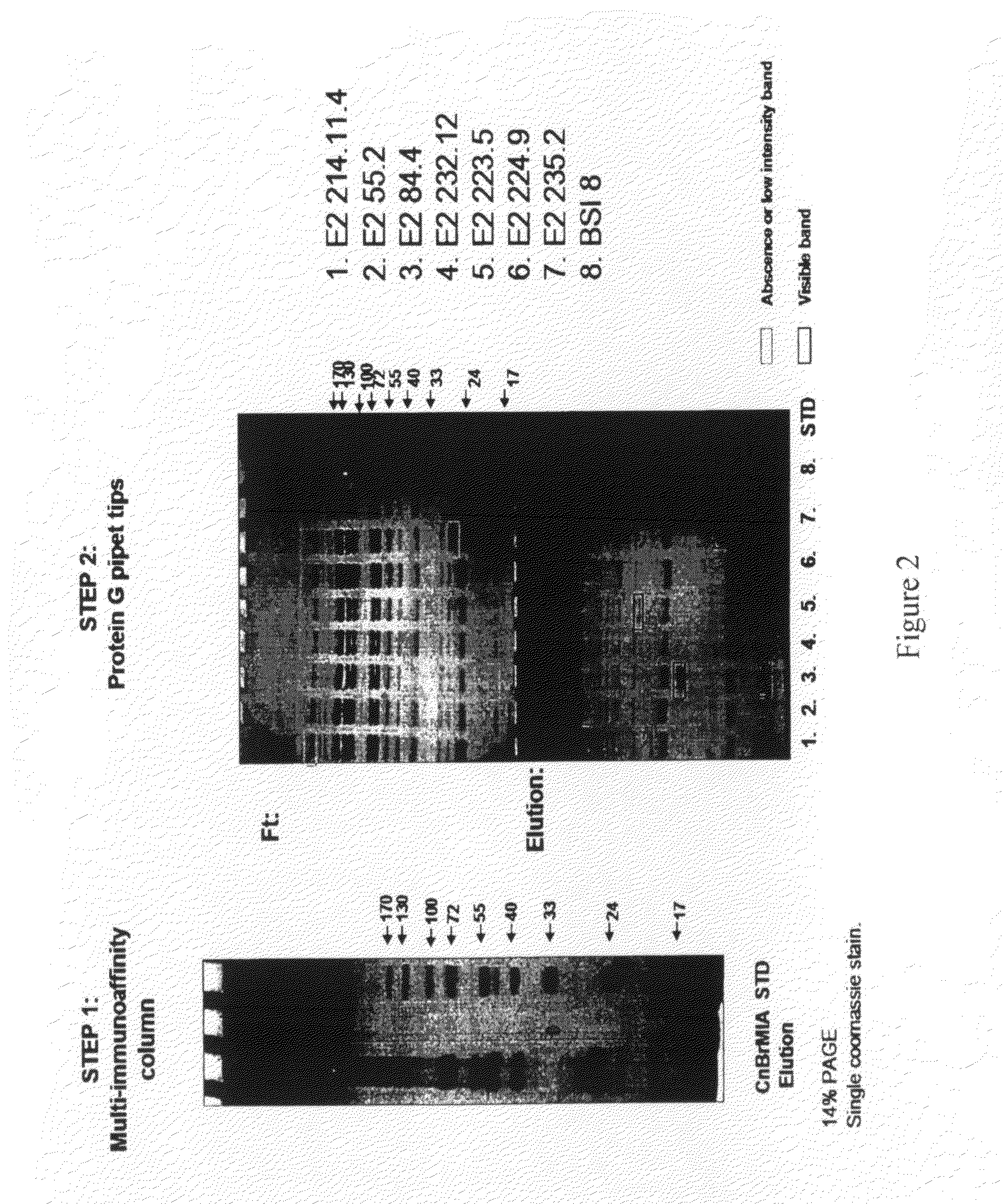Multi-immunoaffinity based antigen identification
a technology of immunoaffinity and antigen identification, applied in the direction of fluid pressure measurement, fluid/fluent solid measurement, peptide measurement, etc., can solve the problem of reducing the success rate of ms based or other identification processes
- Summary
- Abstract
- Description
- Claims
- Application Information
AI Technical Summary
Benefits of technology
Problems solved by technology
Method used
Image
Examples
example-1
Multi Immunoaffinity Column Chromatography
[0037]Bead: CNBr-activated Sepharose 4B (Coupling capacity: 25-60 mg α-chymotrypsinogen / ml drained medium pH stability: 2-11)
1. Media preparation: 1 g lyophilized powder gives about 3.5 ml final volume of medium, and 5-10 mg protein ligand per ml medium is recommended.[0038]Weigh out the required amount of powder, and suspend it in 1 mM HCl[0039]2 g powder, gives 7 ml final volume of medium[0040]Wash the medium washed for 15 minutes with 1 mM HCl on a sintered glass filter[0041]Approximately 200 ml 1 mM HCl per gram freeze-dried powder needed, in several aliquots.
2. Coupling and Blocking
[0042]Dissolve the ligand to be coupled in coupling buffer[0043]Buffer: 0.1 M NaHCO3 pH 8.3, 0.5 M NaCl[0044]About 5 ml coupling solution / g lyophilized powder is recommended.[0045]5-10 mg protein ligand per ml medium is recommended.[0046]Ligand: 2-2 mg purified IgG from ascites (aliquoted in PBS, 10% glycerol)[0047](E2 214.11.4; E2 55.2; E2 84.4; E2 232.12; E...
example 2
Phynexus Chromatography
[0095]Bead / column: 1000+PhyTip columns with Protein G resin: Maximum solution volume of 1000 μL, Protein G resin volume 160 μl; Coupling capacity: ˜1000 μg.
System: Computer controlled 8-channel pipet
1. Tip Preparing
[0096]PhyTip columns with Protein G are stored in Glycerol when shipped from PhyNexus.[0097]Wash the tips with 1 ml PBS[0098]Program: 900 μl intake / expel[0099]0.5 ml / min[0100]Delay (hold): after intake 30 sec, after expel 30 sec[0101]Cycle: 2×[0102]Repeat this step 2 or 3 times with new PBS solution.
2. Coupling and Blocking
[0103]Ligand: 0.3 mg purified IgG from ascites (aliquoted in PBS, 10% glycerol).[0104]1. E2 214.11.4[0105]2. E2 55.2[0106]3. E2 84.4[0107]4. E2 232.12[0108]5. E2 223.5[0109]6. E2 224.9[0110]7. E2 235.2[0111]8. BSI 8[0112]Pipet the ligand in 200 μl (up with PBS to 200 μl) suspension into a 96-well plate separately, according to the numbers (In case of bigger volume, aliquot the ligand suspension to 200-200 μl and intake it separate...
PUM
| Property | Measurement | Unit |
|---|---|---|
| volume | aaaaa | aaaaa |
| volume | aaaaa | aaaaa |
| Bed volume | aaaaa | aaaaa |
Abstract
Description
Claims
Application Information
 Login to View More
Login to View More - R&D
- Intellectual Property
- Life Sciences
- Materials
- Tech Scout
- Unparalleled Data Quality
- Higher Quality Content
- 60% Fewer Hallucinations
Browse by: Latest US Patents, China's latest patents, Technical Efficacy Thesaurus, Application Domain, Technology Topic, Popular Technical Reports.
© 2025 PatSnap. All rights reserved.Legal|Privacy policy|Modern Slavery Act Transparency Statement|Sitemap|About US| Contact US: help@patsnap.com



